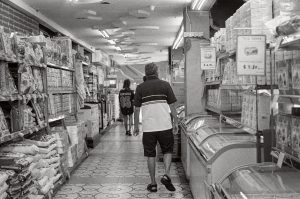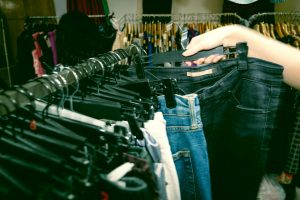All images by Isaiah Chua for Rice Media
Pre-pandemic, I distinctly remember the buzz surrounding vintage clothing. As a broke student in Polytechnic then, I was mesmerized by the YouTube videos of Singaporeans my age showcasing their hauls from the thrift shops, where they claimed to have found stylish clothing, or even rare pieces, at dirt-cheap prices.
Outfits that showcased the colour-blocking of the 80’s era filled my Instagram feed. Second-hand was in style. For a teenager like me, owning brands such as Nike, Ellesse, Champion, and Fila from that era meant that I would look cool and fashionable.
ADVERTISEMENT
A couple of years later, the hype seems to be less apparent. With fewer events and pop-ups, there appears to be less excitement surrounding this subculture. But to understand whether this is only my perception or indeed the end of another social media fad, I set out to speak to shop owners in the Singaporean vintage and thrift scene.
A trip to The Attic
Our first stop of the day was The Attic, Lifestyle Store, thanks to the suggestion of RICE photographer Isaiah.
“If you’re really looking for vintage, then Chang has the real deal,” Isaiah, a frequent customer of the store, claimed.
The Attic is nestled in a corner of the upper floors of Far East Plaza. As we approached it, I couldn’t peel my eyes off the store’s display.
The space was teeming with memorabilia. Statement clothing pieces—a varsity jacket, weathered Lee jeans, and a Justin Bieber shirt—were all hung across the front glass. Behind the store window, partly concealed by a Star-Spangled Banner, was a shelf littered with vintage toys, cameras, and knick-knacks. In particular, it was a singular SIA Barbie Doll, pristine as ever, that caught my eye.
Chang, the veteran vintage dealer
“Hello, nice to meet you. You can call me Chang, like the Chang Beer,” The store’s owner said as he stood up from a camo-printed camping chair to greet us. Before I could start asking him any questions, Chang was already chatting us up about the latest clothes he had secured for his venture.
Chang explained that due to the pandemic, he has converted his unit into a storage space and operates his physical store only on a pop-up basis. He comes by only to snap photos and take measurements of his products to upload online, or to settle logistics.
“I have made good friends throughout the 21 years of my trade here. Sometimes they’ll also drop by for a chat,” remarked Chang. Mid-conversation, a lady, who I presumed to be another tenant in the mall, walks past, handing him a newspaper.
Chang gestures a sign linking to his social media pages. Nowadays, customers are encouraged to browse his Instagram or Facebook page to shop his available stocks, or simply just Direct Message (DM) him asking for what they are looking for. When retrieving requested items, Chang takes off his shoes and clambers over piles of vintage goods, disappearing into the back of the store.
Each piece has its own history
When defining what makes a piece vintage, the consensus among the community is anything that is 20 years and older. However, there are different vintage stores worldwide, each catering to a specific era or period. Most true vintage items should have some form of cultural relevancy or historical importance.
ADVERTISEMENT
As we chatted, Chang let us look at some of his items, occasionally explaining the materials or history behind the piece. For example, Chang showed us a pair of raw denim jeans, pointing out the faded creases around their crotch area, or “whiskers”. Whiskers slowly appear through years of wear and tear and are a good indication that a pair of jeans are well-fitted. Now, whiskers are more commonly pre-fabricated in the factories to emulate a pseudo-vintage look.
As a vintage dealer, Chang is sometimes put in a difficult position. For a fraction of the price, many fast fashion brands could sell items with the same look, like the whiskers found on raw denim jeans. They may not have the same quality or sentimental value, but as Chang puts it, it’s good enough for many people as long as it looks good in pictures.
Vintage and street culture, intertwined
“I can see street culture dying off in Singapore. Many people go for trends, and whatever can gain them instantaneous likes,” Chang states.
“But, there must be a reason why your store has been around for so long,” Isaiah quipped.
Chang paused for a moment. “It’s more of sentimental value. I mean, it’s been 21 years, even before that, as a kid, I would hang out in this mall.”
“People would come and tell me, it’s amazing that you’re the only vintage store left around here. Sure, you can capitalize on being the sole vintage store and profit off the people who want to buy vintage goods. But being the only one gets lonely,” Chang shared.
When Chang first started his business more than two decades ago, he recalled there being many more vintage stores around. But as time went on, many owners closed or embarked on other business ventures.
With The Attic being one of the last few vintage purveyors from the early 2000s, perhaps it was proof that the culture has been on a decline.
“At the end of the day, it’s still sad because there might be no culture or community left. I would love for more people to open such stores. We’re all exploring and appreciating—what they find and what I find might not be the same. It’s all for the love of vintage; that’s what binds us together.”
Thrifting at Function Five
I first discovered Function Five (F-Five) through their now-viral TikTok account, but what caught my attention was an Instagram story of a friend holding up bags of their clothing, bragging about the “steals” she got.
ADVERTISEMENT
Like the true definition of the word thrift, thrifting alludes to accessible pricing. Thrift stores are where shoppers can go to a place and get items like clothing, books and appliances at a low cost.
Despite already being a thrift store, what sets F-Five apart is how they quite literally give clothes away for free. A quick scroll through their Instagram profile shows rows upon rows of promotional offers, a stark contrast to our previous visit to The Attic, which had more curated items for a niche market.
When we arrived at their brick-and-mortar space located off Haji Lane, we were immediately greeted by their friendly social media manager, Aliya, who ushered me into a break room upstairs. The room was filled with mounds of clothing and a washing machine/dryer, the latter of which maintained a low hum throughout our conversation.
It showed me a side to secondhand stores that I didn’t usually think of. Lots of hard work goes into running one’s own thrift shop, from sourcing to cleaning to marketing.
Paving the way for accessibility
“The main reason we opened up a thrift store is for people to be exposed to it. We hope that Singaporeans can be more comfortable with secondhand clothes in the near future and won’t peg them with a negative connotation.” Aliya shares.
The owners were inspired to open up their own store after witnessing large-scale thrift shops thrive in places like America. They felt that other local thrift shops, which might have a few affordable items, still had a rather expensive price model.
In essence, there were not enough true thrift stores in Singapore which were accessible to all.
At F-Five, the emphasis is placed on keeping their prices low and accessible, such that anyone can come into the store. Aliya pulls out her phone to show me pictures of various customers who have visited the store, all from diverse backgrounds and all ages.
Is there a demand for thrift stores?
While Aliya and I chat about accessibility, a man walks into the break room and grabs a stool to sit with us. Aliya introduces him to me as H, one of the co-founders of the store.
“Many people go to thrift shops and think the clothes are ugly, dirty and stained,” H chimes in. “I’m 26 this year. Among my peers, I realized that they don’t go thrift shopping or wear secondhand clothes, but in the younger generation, it’s more prevalent.”
The pair agreed that although they were grateful for the support, there still has to be a shift in mindset amongst Singaporeans.
The owners try to combat this by stocking up items in good condition to show consumers that thrift shopping isn’t “dirty” or “unfashionable”. “By keeping our prices low, it will be ingrained in people’s minds that this shop is accessible. We are happy to give out free stuff so that customers will remember us as a reliable thrift store.”
H shares, “I hope more thrift stores open in Singapore. If it’s just us, we’re never going to convince everyone to accept the culture of thrifting.”
The friendly neighbourhood Loop Garms
Just behind Jalan Besar MRT is Loop Garms, situated within an HDB estate. The founders of Loop Garms, Isaac and FJ, attended my alma mater, Singapore Polytechnic. Although they graduated before I joined the school, I recall the buzz amongst my schoolmates when they first opened their store back in 2018.
Together with Isaiah, I paid them a visit at STAKEOUT, a new store they opened earlier this year also located within the area. As soon as I entered, a frisbee, which I presume came from the playground outside, hit the store’s signage with a thud. The staff were unphased—this seemed to be a regular occurrence for them—and proceeded to issue me a warm welcome.
After a brief exchange with Isaac and FJ, we decided to head out to one of the nearby HDB void decks to have our chat.
The duo first shared that their interest began in their teenage years, where the e-commerce marketplace Karmaloop piqued their interest in streetwear and vintage. Back then, social media wasn’t as crazy. A lot of the information they got regarding clothing or fashion came from certain fashion websites, forums, or physical magazines, explained Isaac.
The pair credits a trip to Japan—where the pair shopped at secondhand stores—as the catalyst that started their foray into the vintage scene in Singapore. “It really showed us what secondhand clothing and vintage clothing can be. The scene there is vibrant and mature. I made an offhand remark to FJ that when we got back, we should start our own store.”
“Feel free to ask us anything!”
When they first opened nearly four years ago, there weren’t many others with the same idea. In the latter half of the year, a sudden interest in vintage clothing saw more vintage stores opening in Singapore. Most, however, operated on a pop-up or seasonal basis. Being one of the few brick-and-mortar stores open 7 days a week helped cement Loop Garms in the memory of Singaporeans.
“Many people were coming in and wondering what vintage was all about. It was useful for them to have a physical space where they could touch and feel these items, and have people that they could ask. For instance, ‘How do you know if an item is vintage?’, ‘What’s the backstory behind an item?’. We could answer those questions on the spot,” said FJ.
Their definition of vintage aligns with that of The Attic–anything 20 years and older, with cultural or historical significance. For Loop Garms they specialize in the ‘80s to early 2000s pop-culture related items, with a particular fondness for movies, music, and anime. The pair labels this “contemporary vintage”.
However, in the span of the three years that Loop Garms has been around, many sellers hopped on the opportunity to profit after the interest in vintage goods boomed, Isaac notes. Some might have seen it as a means to an end, and to capitalize on whatever’s in the mainstream.
“It’s good that more stores are opening up because it put a spotlight on the scene and got more people talking about it. We are more than happy to see new faces on the scene. We hope they can share the right information,” stated Isaac.
Among the community, using “vintage” as a buzzword is a cause for concern. For example, sellers on online marketplaces such as Carousell or even Instagram can just as quickly label any old and secondhand item as vintage. For an everyday audience like you and me, it might be hard for us to identify what is genuine vintage. In such cases, we could easily get ripped off our money.
Change starts with us
For other sellers, live and let live, said the pair—anyone is free to sell whatever they want.
“Within our own space, that’s where we can affect change. That’s where we can share our expertise.”
As part of their self-made IGTV series titled “Serving You Loops”, the pair published a nearly 40-minute long episode in an effort to better educate others on vintage goods and the vintage scene in Singapore.
Isaac explains, “People might ask, why are we so serious about vintage? They claim most Singaporeans want something that looks aesthetically pleasing and isn’t concerned with the backstory of a piece. If we keep having this mindset, then the vintage scene will never get past this stage.”
The onus is still on vintage sellers to spread the correct information and for the audience to keep asking questions. When both sides push each other to do better, the scene can only grow.
FJ shared, “If you look at places like the US and Japan, there are communities there that see vintage as a way of life. In a couple of years, our aim is to be just a fraction of what Japan and the States are—at least as far as appreciating vintage goes.”
As vintage store owners and pioneers of the contemporary vintage scene in Singapore, I could empathize with Loop Garms’ aspirations and struggles in growing the community.
When people mislabel vintage clothing or see it as a bandwagon to hop on, the community is at risk of becoming obsolete once it has cycled out of trend. For instance, any influencer on social media platforms can easily claim that an item is thrifted or vintage, but it would be hard for the common person to discern what is fact and what isn’t.
This mindset has negative ramifications, especially for stores such as Loop Garms and The Attic, who are already relying on a niche community to survive.
In conversation with the three business owners, there was a consensus that most Singaporeans fall into two camps: either price-led or brand-led. Meaning, Singaporeans usually either go for affordable, economical clothing pieces or choose to splurge their money on more recognized brands.
The remainder, people who genuinely appreciate secondhand clothing, end up making up a small but vocal minority. However, I wonder if they will be enough to sustain the industry in the years to come.
For the sub-culture to truly develop, Singaporeans first need to develop a proper appreciation for fashion and secondhand clothing beyond viewing it as a trend.
Secondhand, vintage, and thrifting: are they all the same?
It was only after speaking to the three different stores that I could clearly distinguish the differences between the three terms, which were often thrown around loosely.
The broader term that encompasses the kind of goods sold by three stores is secondhand. As the name suggests, it is anything that has been owned before. It doesn’t have to be old. It can be something that someone bought yesterday and decided to give away the next day. Both vintage and thrifted items fall under this category.
“Singaporeans, in general, don’t really know the difference between thrifted and vintage goods.” shared Aliya. “There’s this general misconception that vintage goods have to be cheap, but it’s not true at all.”
Whether it be The Attic, which has been around for two decades, Loop Garms, who aim to pioneer a new future for the vintage scene, or Function Five, who are bringing accessible clothing to the masses–they are pioneering change for the secondhand clothing scene in Singapore.
What’s next for the secondhand clothing scene?
In a way, the influx of secondhand stores in the past three years shows us a different side—perhaps we are only in the early stages of a radical shift in retail. According to the 2021 Resale Report by ThredUp, the world’s largest fashion resale platform, the global secondhand market is projected to double in the next 5 years, reaching US$77 billion in value.
Younger shoppers power this rise in secondhand. The report posits that over 40% of millennials and Gen Z shoppers have shopped secondhand clotfiveing in the past 12 months, compared to 32% for Gen X and 16% for Baby Boomers.
For Gen Z’s like Isaiah, 19, they were first drawn to the sub-culture of thrifting due to the affordability of secondhand clothing. It was a means for him to access clothes to style himself that he couldn’t afford otherwise as a student living in the States, where thrifting was more prevalent.
However, as the secondhand market grows and thrifting becomes more popular, the increased demand might lead to price hikes at the shops. This gentrification of thrift shops entirely defeats their purpose, which is meant to be affordable and cater to all.
Without their core customer base, once the trend has cycled, these stores may become obsolete as fast as they became popular.
When it comes to vintage clothing, Nicole, 22, shares that vintage clothing opened up a plethora of possibilities when it came to expressing herself. “The clothes you get when shopping vintage are much more meaningful and unique. Although it is pricier, the quality makes up for it,” she said.
However, when it comes to sustaining the hobby, Isaiah shares that his interest has slightly lessened over time. “I think I’ve gotten a bit desensitized since the scene in Singapore is still quite small. You get tired of looking at the same things, and there are only so many stores to explore here.”
In other countries like America, the secondhand clothing industry has grown exponentially, inviting discussions on ethics and sustainability. Back home, the scene is only in its early stages.
While business owners in the secondhand clothing community remain hopeful for the future of secondhand in Singapore, consumers need to be open-minded and be willing to learn more about the scene to keep the scene alive, and hopefully, growing.
In H’s words, “I hope Singaporeans can give it a chance because it’s all about our mindset.”






